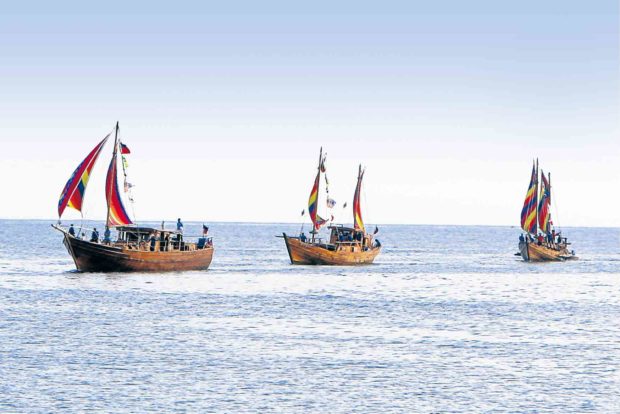‘Sailing is in our DNA’: Balangay back from voyage to China

CONQUERING THE SEAS Three balangay, replicas of pre-Spanish Filipino boats, sail back to San Fernando City in La Union province after an expedition that took them to China. —WILLIE LOMIBAO
SAN FERNANDO CITY — Three replicas of the ancient Filipino sailboat balangay made history on Saturday when they returned, following a successful expedition through the South China Sea from Poro Point here to Xiamen, China.
The voyage of the balangay to China commemorated the travel 600 years ago of Sultan Paduka Pahala of the Sultanate of Sulu to the Middle Kingdom, said Arturo Valdez, expedition leader and a former environment undersecretary, during arrival honors at Poro Point.
Sultan Paduka Pahala sailed to China in 1417 for a tribute mission but he died there and was buried in Shandong, China.
“We covered almost 2,700 nautical miles and crossed the vast South China Sea, which nobody had done before,” Valdez said.
He led 33 crew members of the vessels “Sama ng Tawi Tawi,” “Lahi ng Maharlika” and “Sultan Sin Sulu.” They left Poro Point for Xiamen on April 30 and headed home on May 16.
Article continues after this advertisementValdez said they first planned to go to China in 2009 after the balangay sailed around Southeast Asian countries. But the expedition ended its journey in Vietnam.
Article continues after this advertisementHomesick
He said the China voyage would have enabled them to participate in the world exposition in Shanghai in 2010.
“It was the shift of the monsoon wind that stopped us from pursuing our travel [to China]. With crew members already homesick after traveling for almost 17 months, I decided [to call it off] and told them it was time to go home,” Valdez said.
Last year, after building two more balangay in Maimbung town in Sulu province, Valdez said he again attempted to pursue the trip to China.
But the South China Sea had been rough, prompting him to call off the voyage again.
‘Dungon’
This year, the weather finally gave them a window to sail. “When we arrived in Xiamen, the Chinese were shaking their heads wondering how we managed to get there on a boat like that,” Valdez said.
The balangay, which is about 15 meters long, is made of wood called “dungon.” Using only its sails, a balangay can have a maximum speed of 10 knots. But if its small engine is running, it can move up to 30 knots.
Valdez said the balangay voyage showed that the great seas around the Philippines—the Java Sea, Celebes Sea, Sulu Sea, South China Sea and Gulf of Thailand— are waters that connect the people of Southeast Asia.
The balangay originated from Butuan City. A piece of balangay wood was dug up in 1976 and carbon-dating placed its origin to as far back as 1,700 years ago.
Maritime tradition
“It simply showed that we had a maritime tradition at that time. Sailing is in our DNA because we are the heirs of the great traditions of our maritime forbears,” Valdez said.
John Manginsay, master mariner and skipper of the lead boat Sama ng Tawi Tawi, said they had the scare of their lives when they sailed blindly through heavy fog for 12 hours on the second day of their journey to China.
“Because of prayer, we reached our destination safe and complete,” Manginsay said.
“Our sailboats are very small compared to the modern boats now. We were quite afraid. But we conquered our fear. I think each one of us has a calling to complete this as a team,” he added.
Last voyage
Valdez said the balangay voyage to China would be his last. “To sail in an ancient boat in the modern times is really so risky. We just have to thank God for really taking good care of us,” he said.
“To sail the [balangay] again is pushing your luck too far,” he added.